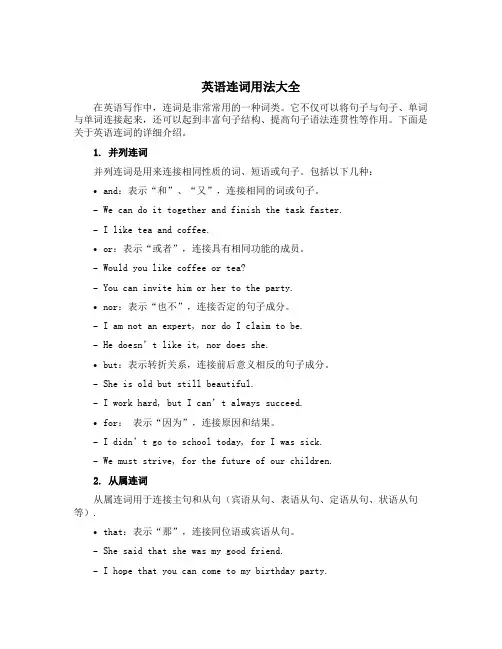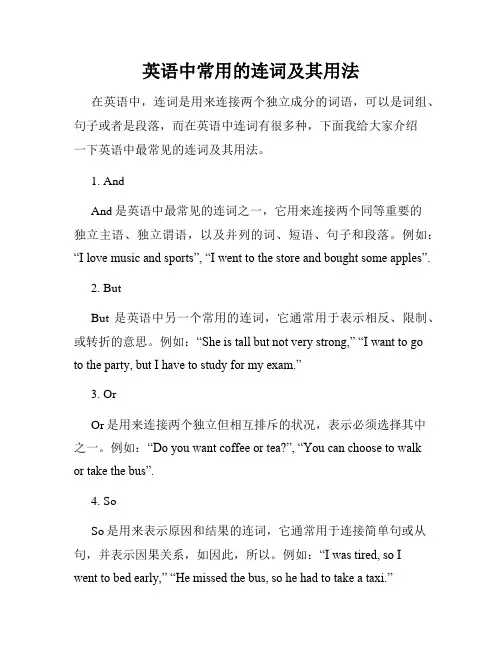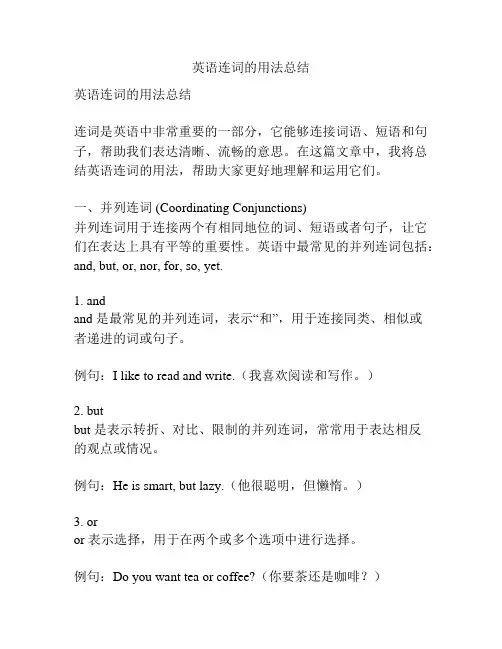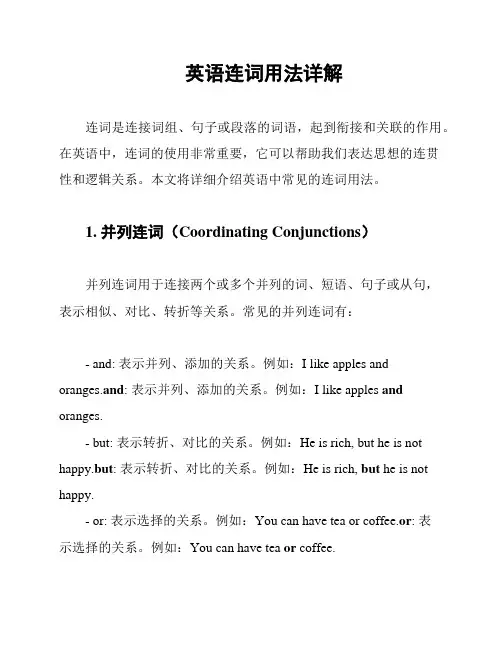英语连词用法
英语连词用法大全

英语连词用法大全在英语写作中,连词是非常常用的一种词类。
它不仅可以将句子与句子、单词与单词连接起来,还可以起到丰富句子结构、提高句子语法连贯性等作用。
下面是关于英语连词的详细介绍。
1. 并列连词并列连词是用来连接相同性质的词、短语或句子。
包括以下几种:•and:表示“和”、“又”,连接相同的词或句子。
–We can do it together and finish the task faster.–I like tea and coffee.•or:表示“或者”,连接具有相同功能的成员。
–Would you like coffee or tea?–You can invite him or her to the party.•nor:表示“也不”,连接否定的句子成分。
–I am not an expert, nor do I claim to be.–He doesn’t like it, nor does she.•but:表示转折关系,连接前后意义相反的句子成分。
–She is old but still beautiful.–I work hard, but I can’t alway s succeed.•for:表示“因为”,连接原因和结果。
–I didn’t go to school today, for I was sick.–We must strive, for the future of our children.2. 从属连词从属连词用于连接主句和从句(宾语从句、表语从句、定语从句、状语从句等).•that:表示“那”,连接同位语或宾语从句。
–She said that she was my good friend.–I hope that you can come to my birthday party.•if:表示“如果”,引导条件从句。
–If it rains tomorrow, we will stay at home.–If I have enough money, I will buy a new car.•because:表示“因为”,引导原因状语从句。
英语中常用的连词及其用法

英语中常用的连词及其用法在英语中,连词是用来连接两个独立成分的词语,可以是词组、句子或者是段落,而在英语中连词有很多种,下面我给大家介绍一下英语中最常见的连词及其用法。
1. AndAnd是英语中最常见的连词之一,它用来连接两个同等重要的独立主语、独立谓语,以及并列的词、短语、句子和段落。
例如:“I love music and sports”, “I went to the store and bought some apples”.2. ButBut是英语中另一个常用的连词,它通常用于表示相反、限制、或转折的意思。
例如:“She is tall but not very strong,” “I want to go to the party, but I have to study for my exam.”3. OrOr是用来连接两个独立但相互排斥的状况,表示必须选择其中之一。
例如:“Do you want coffee or tea?”, “You can choose to walkor take the bus”.4. SoSo是用来表示原因和结果的连词,它通常用于连接简单句或从句,并表示因果关系,如因此,所以。
例如:“I was tired, so Iwent to bed early,” “He missed the bus, so he had to take a taxi.”5. NorNor是用来连接两个同等重要的否定语句的连词或连接两个相互排斥的情况。
例如:“I don’t like coffee, nor do I like tea”, “Neither the chicken nor the fish is fresh.”6. ForFor是用来表示原因的连词。
例如:“I am going to the store for some milk and bread,” “They are late for the meeting because of the traffic jam.”7. YetYet是用来表示否定的连词,它也可以表示转折、或者承接。
英语连词的用法总结

英语连词的用法总结英语连词的用法总结连词是英语中非常重要的一部分,它能够连接词语、短语和句子,帮助我们表达清晰、流畅的意思。
在这篇文章中,我将总结英语连词的用法,帮助大家更好地理解和运用它们。
一、并列连词 (Coordinating Conjunctions)并列连词用于连接两个有相同地位的词、短语或者句子,让它们在表达上具有平等的重要性。
英语中最常见的并列连词包括:and, but, or, nor, for, so, yet.1. andand 是最常见的并列连词,表示“和”,用于连接同类、相似或者递进的词或句子。
例句:I like to read and write.(我喜欢阅读和写作。
)2. butbut 是表示转折、对比、限制的并列连词,常常用于表达相反的观点或情况。
例句:He is smart, but lazy.(他很聪明,但懒惰。
)3. oror 表示选择,用于在两个或多个选项中进行选择。
例句:Do you want tea or coffee?(你要茶还是咖啡?)4. nornor 与 or 相似,但用于否定句中,表示与前面的内容都不同。
例句:He neither drinks nor smokes.(他既不喝酒也不抽烟。
)5. forfor 表示原因或目的。
例句:I study hard, for I want to get good grades.(我努力学习,因为我想取得好成绩。
)6. soso 表示结果或原因,用于连接两个句子。
例句:He is tired, so he wants to take a nap.(他累了,所以想打个盹。
)7. yetyet 表示转折、时间上的久远等,用于连接两个对比强烈的句子。
例句:He is rich, yet unhappy.(他很富有,但不快乐。
)二、从属连词 (Subordinating Conjunctions)从属连词用于连接一个主句和一个从句,它们使得从句变得从属于主句。
英语中连词的用法

英语中连词的用法连词(conjunction)是用来连接词、词组或句子的词类,它可以使句子更加连贯,表达更加清晰。
以下是一些常用的连词及其用法:1. 表示并列关系的连词:- and(和):用于连接两个相似的元素,例如:I like to read books and watch movies.(我喜欢读书和看电影。
)- or(或):用于表达选择或替代的关系,例如:You can choose red or blue.(你可以选择红色或蓝色。
)- but(但是):用于表达转折或对立的关系,例如:She is smart but lazy.(她很聪明但懒惰。
)2. 表示因果关系的连词:- because(因为):用于表示原因,例如:I couldn't go to the party because I had to work.(我不能去参加派对,因为我要工作。
)- so(所以):用于表示结果,例如:It was raining, so I brought an umbrella.(下雨了,所以我带了把伞。
)3. 表示选择关系的连词:- whether...or(无论...还是):用于表示两种选择中的一种,例如:I don't know whether to go or stay.(我不知道是去还是留下。
)- either...or(要么...要么):用于表示两种选择中的一种,例如:You can eithercome with me or stay here.(你要么和我一起去,要么留在这里。
)4. 表示递进关系的连词:- and(并且):用于表示两个或多个事物的相互补充或递进关系,例如:I bought fruits and vegetables.(我买了水果和蔬菜。
)- moreover(此外):用于表示补充的信息,例如:He is smart, moreover, he is also kind.(他很聪明,而且他也很善良。
英语连词用法详解

英语连词用法详解连词是连接词组、句子或段落的词语,起到衔接和关联的作用。
在英语中,连词的使用非常重要,它可以帮助我们表达思想的连贯性和逻辑关系。
本文将详细介绍英语中常见的连词用法。
1. 并列连词(Coordinating Conjunctions)并列连词用于连接两个或多个并列的词、短语、句子或从句,表示相似、对比、转折等关系。
常见的并列连词有:- and: 表示并列、添加的关系。
例如:I like apples and oranges.and: 表示并列、添加的关系。
例如:I like apples and oranges.- but: 表示转折、对比的关系。
例如:He is rich, but he is not happy.but: 表示转折、对比的关系。
例如:He is rich, but he is not happy.- or: 表示选择的关系。
例如:You can have tea or coffee.or: 表示选择的关系。
例如:You can have tea or coffee.- so: 表示因果、结果的关系。
例如:It started to rain, so we decided to stay indoors.so: 表示因果、结果的关系。
例如:It started to rain, so we decided to stay indoors.2. 从属连词(Subordinating Conjunctions)从属连词用于引导从句,连接主句和从句,表示时间、原因、条件、目的、方式等关系。
常见的从属连词有:- because: 表示原因。
例如:We canceled the trip because of bad weather.because: 表示原因。
例如:We canceled the trip because of bad weather.- after: 表示时间顺序。
英语连词用法

英语连词用法连词是英语书写和口语表达中极其重要的一类语言现象,连词能够把一个句子中前后不相关的词语有机地联系起来,使它们成为一个整体。
一般来说,英语中常用的连词有and, but, so,or, nor, yet, for, therefore, thus, however, besides等,它们在句子中承担不同的功能,以下就将这些连词分别介绍:1、and是连接并列的词语、短语、句子。
在句子中,可以用and连接两个并列的名词、主语、谓语、宾语、表语、定语、状语等,如:He works hard and gets good result。
2、but表示转折,常跟随否定词连用,如:He is young, but he knows a lot。
3、so表示因果关系,如:He studies hard, so he gets good marks。
4、or表示选择关系,如:He can go by bus or by plane。
5、nor表示也不,与neither通用,如:He cannot speak English nor French。
6、yet表示反常的结果,如:He was lazy, yet he passed the exam。
7、for表示原因,如:She is late for she missed the bus。
8、therefore表示结果,如:He worked hard, therefore he passed the exam。
9、thus表示自然的结果,如:He studied hard, thus he got a good result。
10、however表示让步,如:He is young, however he is wise。
11、besides表示除此之外,如:He can speak English, besides French。
英语中的连词及其用法
英语中的连词及其用法连词是连接词与词、短语与短语,以及句子与句子之间的重要工具。
它们能够帮助我们在表达中建立逻辑关系,使句子更加连贯和流畅。
在英语中,有许多种不同的连词,每种连词都有其特定的用法和意义。
在本文中,我们将讨论几种常见的连词及其用法。
1. 并列连词并列连词用于连接同等重要的词、短语或句子,使它们成为并列结构。
常见的并列连词有"and"、"but"和"or"。
- "And"用于表示两个或多个相似、相关或并列的事物之间的关系。
例如:"I like apples and oranges."(我喜欢苹果和橙子。
)- "But"用于表示转折、对比关系或否定后件。
例如:"He is smart but lazy."(他很聪明但很懒。
)- "Or"用于表示选择或提供两种或多种可能性。
例如:"Would you like tea or coffee?"(你想要茶还是咖啡?)2. 递进连词递进连词用于表示一种渐进的关系,追加一个补充性的想法。
常见的递进连词包括"moreover"、"furthermore"和"in addition"。
- "Moreover"用于表示一个进一步的事实或观点。
例如:"She is intelligent. Moreover, she is also hardworking."(她很聪明。
此外,她也很勤奋。
)- "Furthermore"用于追加另一个论点。
例如:"The weather is nice today. Furthermore, I have the day off."(今天天气很好。
最全英语连词用法大全+连词总结
英语连词用法大全+连词总结目录一、概述1二、并列连词的用法2(一)、表示转折关系的并列连词2(二)、表选择的并列连词6(三)、表示因果关系的并列连词7(四)、表示并列关系的并列连词9三、从属连词的用法12(一)、引导时间状语从句的从属连词12(二)、引导条件状语从句的从属连词14(三)、引导目的状语从句的从属连词16(四)、引导结果状语从句的从属连词17(五)、引导原因状语从句的从属连词17(六)、引导让步状语从句的从属连词20(七)、引导方式状语从句的从属连词22(八)、引导地点状语从句的从属连词22(九)、引导比较状语从句的从属连词23(十)、引导名词从句的从属连词等23四、并列连词词组的用法23(一)、both…and…的用法23(二)、either…or…的用法23(三)、neither…nor…的用法24(四)、not only…but also…的用法25(五)、not only…but also…和对称结构26五、连词总结28一、概述连词是一种虚词,用于连接单词、短语、从句或句子,在句子中不单独用作句子成分。
连词按其性质可分为并列连词和从属连词。
并列连词用于连接并列的单词、短语、从句或句子,如and, but, or, for等;从属连词主要引出名词性从句(主语从句、宾语从句、表语从句等)和状语从句(时间状语从句、条件状语从句、目的状语从句等),引出名词性从句的连词如that, whether等,引出状语从句的连词如when, because, si nce, if 等。
二、并列连词的用法(一)、表示转折关系的并列连词。
主要有 but(但是), yet(可是), while(而,却)等。
如:I would have written before but I have been ill. 我本该早写信的,但我生病了。
I have failed, yet I shall try again. 我失败了,但我还要尝试。
英语连词总结
英语连词总结英语连词的用法归纳,连词是连接词、短语、从句或句子的词。
连词是虚词,不能在句中单独作句子成分。
根据含义及其所连接成分的性质,连词可以分为并列连词和从属连词。
一、并列连词1. 表示同等关系这类连词主要有:and, neither…nor…,not only…but(also)…,both…and…,as well as等。
例句:The weather is mild today;it is neither hot nor cold.语法:句中的neither…nor…是表示同等关系的并列连词,连接两个同等关系的表语。
译文:今天的天气很温和,既不热也不冷。
2. 表示转折关系这类连词主要有:but, yet等。
例句:Someone borrowed my pen, but I don't remember who.语法:句中的but是表示转折关系的并列连词,连接两个转折关系的简单句。
译文:有人借了我的钢笔,但我不记得是谁了。
3. 表示因果关系这类连词主要有:so, for等。
例句:The child had a bad cough, so his mother took him to the doctor.语法:句中的so是表示因果关系的并列连词,连接两个因果关系的简单句。
译文:这个孩子咳嗽得很严重,所以他的妈妈带他去看医生。
4. 表示对比关系这类连词主要有:while, whereas等。
例句:Some people praise him, whereas others condemn him.语法:句中的whereas是表示对比关系的并列连词,连接两个对比关系的简单句。
译文:有些人赞扬他,而有些人谴责他。
5. 表示选择关系这类连词主要有or, either…or…等。
例句:Either you can talk to him, or I will.语法:句中的Either…or…是表示选择关系的并列连词,连接两个选择关系的简单句。
英语连词的用法总结
英语连词的用法总结连词在英语中起着连接句子、短语和词语之间关系的作用。
它们能够使句子更加连贯,表达出更复杂的意思。
以下是一些常见的英语连词及其用法总结:1. 并列连词(Coordinating Conjunctions):- 这类连词用于连接同等重要的句子、短语或词语。
常见的并列连词有:"and"(和)、"but"(但是)、"or"(或者)、"so"(所以)、"for"(因为)等。
- 例句:I like to play football, but my brother prefers basketball.2. 从属连词(Subordinating Conjunctions):- 从属连词用于连接主从句,引导一个句子的附属部分。
常见的从属连词有:"if"(如果)、"because"(因为)、"although"(虽然)、"when"(当)、"while"(当...的时候)等。
- 例句:He couldn't go to the party because he was sick.3. 连接副词(Conjunctive Adverbs):- 连接副词用于连接两个句子、短语或词语,并表示前后句之间的关系。
常见的连接副词有:"however"(然而)、"therefore"(因此)、"moreover"(此外)、"nevertheless"(然而)、"hence"(因此)等。
- 例句:She studied hard for the exam; therefore, she was able to get a good grade.4. 关联词(Correlative Conjunctions):- 关联词是成对出现的连词,用于连接两个平等的句子、短语或词语。
- 1、下载文档前请自行甄别文档内容的完整性,平台不提供额外的编辑、内容补充、找答案等附加服务。
- 2、"仅部分预览"的文档,不可在线预览部分如存在完整性等问题,可反馈申请退款(可完整预览的文档不适用该条件!)。
- 3、如文档侵犯您的权益,请联系客服反馈,我们会尽快为您处理(人工客服工作时间:9:00-18:30)。
1.引导名词性从句的连词
(1)That,whether,if不充当句子成分的。
其
中that不仅没有充当句子成分,
而且没有词义,在句子中只起连接作用。而
if,whether虽然不充当句子成分,但有词
义,表示“是否”。如
He replied that he was going by train.
I wonder if it’s large enough.
二.从属连词是用来引导连接主句和从句的连词。 分为引导名词性从句的连词和引导状语 从句的连词。(分为连接代词和连接副词)
(1). that, whether, if 不充当成分.
(2). 连接代词 who, whom, which, what 充当主, 宾, 定, 表语等.
(3). 连接副词 when, where, how, why 状语.
Somebody borrowed my pen, but I don’t remember who.
He said he was our friend, yet he would help us.
4.表示因果关系的连词
so for thus(因此) therefore (因此)consequently(因而,所以) 1.The child has a bad cough, so his mother take him to the doctor. 2.You are supposed to get rid of carelessness, for it often leads to serious errors. 注意:for通常不能用于句首,也不能单独使用。
I worry about whether I hurt her feelings.
(2)连接代词who,whom,which,what充当主, 宾,定,表语等。
The boys who are playing football are from Class One.(充当主语)
He is not what he used to be.(充当表语) Which team has won the game is not known yet.(充当定语) He asked whom I borrowed the money from. (充当宾语)
If you will sit down for a few moments, I’ll tell the manager you are here.
(5). 让步:though/ although不与but连用. as(尽管), even if/ though (即使) however(无论怎样), whatever no matter how/ who/ which
(3). 连接副词 when, where, how, why
2. 引导状语从句的连词
(1). 时间: when, while, as 当…时 as+瞬间,延续性动词 “一边…一边” since, till/until, as soon
as(一…就), the moment/instant(一…就), Don’t talk while you are eating. She’s been playing tennis since she was eight. The moment I finish I’ll give you a call.
Although they are twins, they look entirely different. Whoever you are, you can’t pass this way. Whenever I see him I speak to him.
(6).结果:So...that, such...that I went to the lecture so early that I got a good seat. (7).目的:so that, in order that He raised his voice so that everyone could hear. (8).方式:as(按照), as if, as though Why didn’t you catch the last bus as I told you to.
*连 词
conjunction
小组成员:田焜鹏,韦栋,明谣
连词是一种虚词, 它不能独 立担任句子成分。用来连接词, 短语,从句与句子。
连词主要可分为两类: 并列连词 从属连词
一.并列连词表示词,短语, 从句或句子之间具有并列关系。 可以表示并列关系,转
(2). 原因: as because for since
For语气最弱, 引导的分句放在句末. Because 语气最强, 句首,句末均可. As(因为) 置于句首. Since(既然) 通常置于句首.
(3). 地点: where, wherever, anywhere I’ll take you anywhere you like.
2.He is a scientist as well as a poet.
3.Are they coming as well?
4.Both New York and London have traffic problems.
2.表示转折关系的连词:
but while (而, 虽然) yet (可是) however (而)
(4). 条件: if, unless= if… not, so/as long as, suppose(that)假使
Do you mind if I open the window?
Don’t come unless I telephone.
注意:在条件状语从句中,通常要用一般现在时 表示将来意义,而不能直接使用将来时态。不过, 有时条件的if后可能用will,但那不是表示将来时 态,而是表示意愿或委婉的请求。如:
and (和) both … and(和,两者都) or(或者) neither… nor(既不…也不…) not only… but also(不但… 而且…) as well as (和, 也, 除…外, 而且)
as well (也,而且,) 用于句末.
1.He is a scientist, but he is a poet as well.
